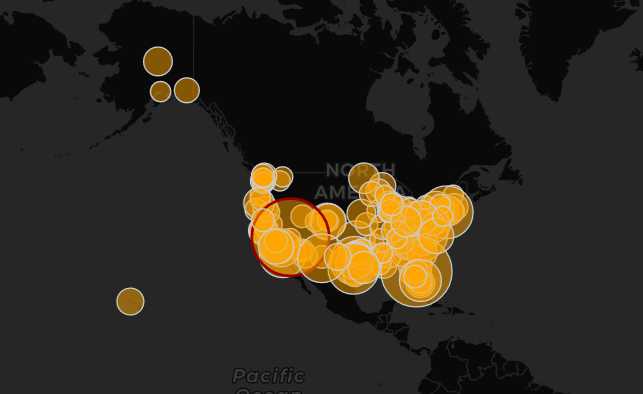[content id=”79272″]
“Intimate partner firearm homicide is increasing as the Supreme Court debates whether people subject to domestic violence restraining orders should be allowed to possess firearms,” said the president of national gun control group Brady.

As the U.S. Supreme Court prepares to hear a case centered on a law that restricts access to firearms for domestic abusers, an analysis out Thursday shows how “the safety of domestic violence survivors, their families, and the American public” will be placed at risk if the court loosens those restrictions.
The group behind the report—Brady: United Against Gun Violence, whose founders fought to require background checks for firearm sales—determined that firearm homicides committed by an intimate partner went up by 22% from 2018-22, with states that have weak gun regulations seeing the most domestic abuse-related murders.
The group found that 782 people were killed by a current or former intimate partner with a gun in 2022, up from 642 in 2018. As the coronavirus pandemic was linked to an overall rise in domestic violence, a high of 856 firearm homicides by domestic abusers were recorded in 2021.
As firearms prove increasingly deadly for people facing intimate partner violence and abuse, the Supreme Court is set to hear oral arguments in U.S. v. Rahimi on November 7. The respondent in the case, Zackey Rahimi, argues that his Second Amendment rights are violated by federal laws prohibiting him from possessing a firearm due to a domestic violence restraining order filed against him.
The federal government has prohibited people subject to such restraining orders from purchasing guns since 1994, and the law was expanded to include people convicted of domestic violence two years later. In 2022, the Bipartisan Safer Communities Act closed the so-called “boyfriend loophole” in the earlier law, which had only pertained to abusers who were married to, had a child with, or were the parent or guardian of the person who filed an order against them.
The U.S. Court of Appeals for the Fifth Circuit sided with Rahimi earlier this year—a decision that will carry “horrific ramifications, particularly for women and children,” said Brady president Kris Brown, if it is allowed to stand.
“This analysis shows that intimate partner firearm homicide is increasing as the Supreme Court debates whether people subject to domestic violence restraining orders should be allowed to possess firearms,” said Brown. “We know that firearms are the most common weapons used in domestic violence homicides, with female intimate partners more likely to be murdered with a gun than by all other means combined. Prohibiting domestic violence abusers from accessing firearms is common-sense, life-saving, and constitutional.”
Brady noted in its analysis that even in rulings that weakened gun control regulations, such as New York State Rifle & Pistol Association v. Bruen and District of Columbia v. Heller, the Supreme Court has “repeatedly stated… that the Second Amendment provides ‘law-abiding, responsible’ citizens the right to possess firearms, but also allows for reasonable restrictions in service of public safety.”
“Domestic abusers who are subject to a court ordered domestic violence restraining order—including Zackey Rahimi—are not ‘law-abiding, responsible’ citizens,” reads the analysis. “If the Supreme Court allows the Fifth Circuit’s decision to stand, the lives of countless individuals who are protected under domestic violence restraining orders will be put at risk.”
The group noted that weaker state-level gun regulations are linked to deadly outcomes for people who face domestic abuse, with Texas, Florida, Georgia, Alabama, and Tennessee ranking as the top five states with the highest average number of intimate partner firearm homicides per year.
All five of the states have loopholes in their gun laws allowing people to buy guns online, at gun shows, or in other private transactions without a background check.
“This gap in the law creates a path for domestic abusers to avoid the Brady Background Check system and purchase firearms despite being prohibited,” said Brady.
Twenty-two states and Washington, D.C. have laws requiring people subjected to domestic violence restraining orders to surrender their firearms, and on average, the group said, states that do not have such requirements see nearly twice as many firearm homicides by intimate partners.
Along with increasing the risk of homicide by 500% for the estimated 10 million people who face domestic violence in the U.S. each year, domestic abusers’ access to firearms puts the greater public at risk, according to the analysis.
“In the United States,” the report reads, “60% of mass shooting events between 2014-19 were either domestic violence attacks or perpetrated by those with a history of domestic violence. Several perpetrators of high-profile school shootings—including in the Parkland shooting, the Santa Fe High School shooting, and the Great Mills High School shooting—have histories of adolescent dating violence.”
With the support of leading anti-domestic violence advocacy groups, Brady filed an amicus brief with the court in August in opposition of the Fifth Circuit’s ruling, noting that 25 million adults in the U.S. have been threatened or injured by an intimate partner with a gun—and there is a 16% in homicides when guns are taken from the abuser by law enforcement in these cases.
“The Supreme Court must prioritize survivor safety over a dangerous abuser’s access to firearms,” said Brown, “and overturn this deadly ruling.”
Common Dream’s work is licensed under a Creative Commons Attribution-Share Alike 3.0 License. Feel free to republish and share widely.
[content id=”79272″]








